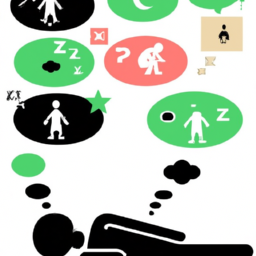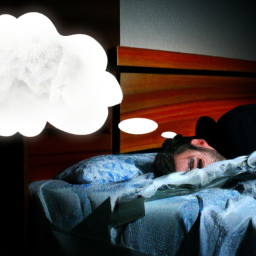As someone fascinated by the complexities of the mind, I have spent countless hours pondering the significance of dreams. What do they mean? Why do we dream? And perhaps most intriguing of all, what hidden symbols and visions lurk in our subconscious, manifesting in our dreams?
The study of dreams has been a subject of fascination for centuries, with cultures from all around the world delving into their meanings and interpretations. From ancient civilizations to modern psychologists, dreams have been seen as a powerful tool for understanding ourselves and our place in the world.
In this article, we will explore some common symbols found in dreams, analyze different approaches to interpreting them, and uncover how cultural and historical factors shape our understanding of this mysterious realm of consciousness.
Key Takeaways
- Symbols in dreams offer clues about hidden or repressed aspects of ourselves.
- Context and emotions must be considered to fully understand the message of a dream.
- Carl Jung’s theory of archetypes suggests that certain symbols have universal meanings ingrained in our collective unconscious.
- Analyzing personal associations is crucial in interpreting dreams.
The Meaning and Significance of Dreams
Dreams hold a mysterious power that can transport us to another world, revealing hidden truths about ourselves and our deepest desires. The psychology of dreaming has long fascinated me, as it offers a window into the workings of the subconscious mind.
Dreams often serve as a mirror for our waking life experiences, allowing us to process emotions and make sense of complex situations. One technique for exploring the depths of our dreams is lucid dreaming. This practice involves becoming aware that we are dreaming while still in the dream state, enabling us to take control and influence the direction of the dream.
Lucid dreaming can be used as a tool for personal growth and self-discovery, allowing us to confront fears or work through unresolved issues. By tapping into our unconscious mind through dreams, we gain valuable insights into ourselves and our place in the world.
As we explore these inner realms, we begin to recognize common symbols found in dreams that hold significance for each individual. These symbols can offer clues about aspects of ourselves that may be hidden or repressed. By decoding these messages from our subconscious mind, we open up new possibilities for growth and transformation in both our waking and dream lives alike.
Common Symbols Found in Dreams
Many people experience recurring symbols in their dreams, with up to 70% of individuals reporting common themes such as falling, flying, or being chased. These symbols hold significant meaning and are often interpreted differently based on cultural variations. For example, the symbol of a snake may represent danger and deceit in Western cultures, while in Eastern cultures it can be viewed as a symbol of transformation and rebirth.
To interpret the symbolism in dreams, there are multiple methods that can be used such as examining personal associations with the symbol or looking at the context of the dream. A common method is Carl Jung’s theory of archetypes which suggests that certain symbols have universal meanings that are ingrained in our collective unconscious. However, interpretation ultimately depends on individual experiences and beliefs.
As we explore further into the interpretation of dreams, it becomes apparent that understanding these symbolic messages can lead to greater self-awareness and personal growth.
Interpretation of Dreams
When it comes to interpreting dreams, I believe that analyzing personal associations is crucial. It’s important to recognize symbols and their meanings, both universal and personal. However, context and emotions must also be taken into consideration in order to fully understand the message of a dream.
Analyzing Personal Associations
As I think about my own dreams, they represent a glimpse into my subconscious mind. They’re often reflections of my personal experiences and emotions that’ve been buried deep within me.
Dream journaling has helped me to analyze these symbols and their meanings, giving me insight into myself that I may not have otherwise recognized.
For instance, when I dream about flying, it represents a sense of freedom and liberation. When I dream about falling, it symbolizes fear or anxiety. These associations may be unique to me, but they hold symbolic meaning in my life.
Recognizing these personal associations is the first step in understanding the universal symbols that unite us all.
Recognizing Universal Symbols
You may not have realized it, but certain symbols hold universal meanings that can be recognized across cultures and time periods. These symbols provide a window into the subconscious mind, allowing us to decode hidden messages within our dreams.
One of the most famous theorists in this field is Carl Jung, who believed in the existence of collective unconsciousness – a shared pool of symbols that are inherited by all humans. Jungian archetypes, such as the hero or the shadow, are examples of these universal symbols that can appear in our dreams.
The hero represents strength and courage while the shadow symbolizes repressed thoughts and emotions. By recognizing these archetypes in our dreams, we can gain insight into our innermost desires and fears.
Decoding universal symbols requires a deep understanding of human nature and culture, but once mastered, it can unlock powerful insights about ourselves and others.
Recognizing universal symbols is only one part of understanding dream symbolism. It’s also important to consider context and emotions when interpreting dreams. Without taking into account personal experiences or cultural background, we risk misinterpreting the true meaning behind a dream symbol.
In the next section, we will explore how considering context and emotions can help us better understand what our dreams are trying to tell us.
Considering Context and Emotions
So, if you want to truly understand what your subconscious is trying to communicate, it’s important to take into account the contextual influences and emotional impact surrounding the symbols in your dreams. Dreams can be influenced by our daily experiences, thoughts, and feelings; therefore, understanding the context of our dreams can provide insight into what we need to work on or change in our waking lives.
Emotions also play a crucial role in dream symbolism. Our emotions are often heightened during sleep because our rational mind is at rest, allowing us to tap into deeper levels of consciousness. Therefore, paying attention to how we feel during certain dream scenarios can reveal unconscious fears or desires that need attention.
Overall, considering both context and emotions when interpreting dream symbols can help us gain a more profound understanding of ourselves and our subconscious minds.
As we delve deeper into the analysis of dreams from a Freudian perspective, one must remember that while there are universal symbols that exist across cultures and individuals, Freud believed that each symbol had unique significance for each person based on their personal history and experiences.
Freudian Analysis of Dreams
As I delve deeper into the Freudian Analysis of Dreams, I’m fascinated by the idea that our dreams are a manifestation of our unconscious desires and repressed memories.
Freud believed that these unconscious thoughts and feelings were often too painful or taboo to be expressed in waking life, so they found their way into our dreams instead.
Additionally, he placed great emphasis on the role of sexual symbolism in dreams, believing that even seemingly innocent objects or actions in a dream could represent sexual desires or anxieties.
Overall, this approach offers a unique perspective on the hidden messages within our subconscious minds and how they can manifest themselves through our dreams.
Unconscious Desires and Repressed Memories
Our deepest desires and forgotten memories can manifest in our dreams. According to psychological theories, our unconscious mind holds repressed emotions that we may not be aware of when we’re awake. These emotions include fear, anger, sadness, and joy. When we dream, these emotions come to the surface and become symbols that represent what’s going on in our subconscious.
When we keep a dream journal, it helps us understand what these symbols mean. Here are four things to keep in mind when interpreting your dreams: 1) pay attention to recurring themes or symbols; 2) consider how you felt during the dream; 3) think about what’s going on in your life right now; and 4) be open-minded and willing to explore deeper meanings.
By analyzing our dreams through this lens, we can uncover hidden truths about ourselves that can help us grow and heal. As we delve deeper into the symbolism of our dreams, it’s important to consider the role of sexual symbolism. This is a topic that Freudian analysis touched upon extensively but is still relevant today.
The Role of Sexual Symbolism
Who would’ve thought that objects like bananas, snakes, and tunnels in our dreams could be interpreted as sexual symbols?
As a psychology enthusiast, I find it fascinating how exploring taboo topics in our subconscious mind can reveal psychological implications. Sexual symbolism in dreams is a common occurrence and often indicates repressed desires or fears.
According to Freudian theory, sex is at the core of human behavior, and its repression can manifest itself in various forms such as anxiety, neurosis, or even physical symptoms. Therefore, analyzing sexual symbols in our dreams can provide insight into unconscious desires that we may not be aware of.
For instance, dreaming of a snake could represent phallic imagery while dreaming about tunnels could symbolize vaginal imagery. By exploring these symbols through dream analysis with a therapist or self-reflection, we may uncover hidden aspects of ourselves that need attention or healing.
Moving on from the role of sexual symbolism in dreams, Jungian analysis delves deeper into the symbolic language of the unconscious mind. In this approach to dream interpretation, symbols are seen as archetypes representing universal patterns of human experience rather than purely personal experiences.
Let’s explore this further by examining how Jungian analysis operates…
Jungian Analysis of Dreams
You’ll be fascinated by the Jungian Analysis of Dreams, which delves into the symbolic meaning behind your dreams. The Swiss psychiatrist Carl Jung believed that dreams reflect a collective unconscious shared by all human beings.
According to his theory, this collective unconscious contains archetypes or universal symbols that are inherited from our ancestors. Analyzing archetypes in dreams can help us understand our own psyche and the deeper meaning behind our actions and thoughts.
For example, if you dream about a wise old man, this could represent your own inner wisdom or the guidance of a mentor figure in your life. By interpreting these symbols and exploring their connection to our personal experiences, we can gain insight into ourselves and achieve greater self-awareness.
This is just one approach to understanding the symbolic language of dreams; stay tuned for more on modern approaches to dream analysis.
Modern Approaches to Dream Analysis
Modern approaches to dream analysis have evolved beyond Jung’s archetypes, utilizing techniques such as cognitive-behavioral therapy and neurobiological research to understand the psychological significance of dreams.
From a psychoanalytic perspective, dreams are believed to be manifestations of repressed desires and emotions that need to be brought into conscious awareness.
Cognitive approaches, on the other hand, view dreams as a way for the brain to process information and consolidate memories.
To better understand the symbolism in our dreams, modern dream analysts use various methods such as keeping a dream journal, exploring recurring themes and symbols, and analyzing the emotions experienced during the dream.
These new methods provide deeper insights into our subconscious and help us interpret what our unconscious is trying to tell us. By understanding the meaning behind our dreams, we can gain greater self-awareness and improve our mental wellbeing.
As we move towards lucid dreaming, we continue on this path of self-discovery by gaining more control over our dreams and uncovering even greater depths of insight into ourselves.
Lucid dreaming allows us to become active participants in our dream world rather than mere observers. It offers an opportunity for us to explore different aspects of ourselves and confront fears or unresolved issues that may be holding us back in waking life.
Let’s now delve deeper into lucid dreaming and how it can unlock hidden potential within ourselves.
Lucid Dreaming
Lucid dreaming allows us to unlock hidden potential within ourselves and become active participants in our dream world. It offers a unique opportunity for self-exploration and growth. By exploring techniques such as reality checks and dream journaling, we can learn to recognize when we are dreaming and take control of our actions within the dream. This ability not only leads to exciting adventures but also provides immense benefits to our personal development.
One of the most significant benefits of lucid dreaming is that it allows us to confront and overcome our fears. When we realize that we are in a dream, we can consciously choose to face our anxieties head-on without any real-world consequences. Additionally, lucid dreaming helps us understand ourselves better by allowing us to explore subconscious desires and thoughts that may be difficult to access during wakefulness. Through this introspection, we gain insights into our true selves and can work towards becoming the best versions of ourselves possible.
As much as lucid dreaming can offer incredible opportunities for self-growth, it’s important not to overlook the potential dangers of nightmares. These terrifying dreams can leave lasting emotional scars on individuals if left unchecked. Therefore, it’s essential always to address these issues before they become more severe problems in life.
Nightmares
Nightmares can be a terrifying experience that leaves us feeling shaken and disturbed. As someone who’s experienced frequent nightmares, I’ve come to understand the importance of exploring the causes and triggers behind them.
Coping strategies such as journaling, relaxation techniques, or talking to a trusted friend can help alleviate the fear and anxiety that often accompanies these dreams. However, if nightmares persist and begin to interfere with daily life, seeking professional help from a therapist may provide valuable insight into underlying psychological issues.
Causes and Triggers
You’re probably familiar with the various things that can set off those fascinating and mysterious nighttime visions. These dreams can be caused by a number of factors, including stress factors and environmental stimuli.
Stressful events in our lives, such as work pressure or relationship problems, can trigger vivid and intense dreams. Additionally, external stimuli like sounds or smells in our environment can affect our subconscious mind.
It’s important to note that not all dreams are negative or anxiety-inducing. Positive experiences during waking hours can also lead to pleasant dream states. For example, spending time with loved ones or engaging in pleasurable activities may result in happy and comforting dreams.
Understanding the causes and triggers of your dreams can help you better understand your own emotional state and improve overall mental health.
In the next section, we’ll explore some coping strategies for managing both positive and negative dream states without interrupting your sleep cycle.
Coping Strategies
To manage both positive and negative dream states, there are coping strategies that can be put into place. One effective strategy is to practice mindfulness exercises before bed. This can involve taking a few minutes to focus on your breath and clear your mind of any distracting thoughts. By doing so, you may find that you have a more restful night’s sleep and experience fewer disturbing dreams.
Another helpful technique is to use relaxation techniques such as progressive muscle relaxation or visualization. These methods can help calm the body and mind, making it easier to fall asleep and reducing the likelihood of nightmares or vivid dreams. Additionally, keeping a dream journal can provide insight into recurring themes or symbols in your dreams, allowing for greater self-awareness and understanding of your subconscious mind.
Incorporating these coping strategies into your nightly routine can lead to more peaceful and fulfilling sleep experiences. However, if persistent nightmares or other disturbing dream states continue to impact your daily life, it may be beneficial to seek professional help from a therapist or sleep specialist.
Seeking Professional Help
If persistent disturbing dream states continue to impact your daily life, it’s like trying to drive a car with a flat tire – seeking professional help from a therapist or sleep specialist can fix the issue and get you back on track towards better mental health.
There are many benefits of seeking professional help for your dreams. A trained therapist can provide a safe and non-judgmental space for you to explore your thoughts and feelings, and offer guidance on coping strategies that work best for you.
It’s important to choose the right professional when seeking help for your dreams. Look for someone who’s licensed, experienced in working with clients who have similar issues as you, and has positive reviews from previous clients. It may also be helpful to schedule an initial consultation with the therapist before committing to regular sessions to ensure that they’re a good fit for you.
With the right support, understanding, and guidance, it’s possible to overcome persistent disturbing dream states and improve overall mental well-being.
As we move forward into discussing the cultural and historical significance of dreams, it’s important to remember that seeking professional help is just one step towards unlocking the deeper meaning behind our nightly visions.
Cultural and Historical Significance of Dreams
Throughout history, dreams have been considered a mystical and powerful force that reveal hidden truths about one’s self and the world around them. In ancient Greece, dreams were believed to be messages from the gods or ancestors, providing insight into future events. Similarly, in many Native American cultures, dreams were seen as a means of communication with spirits and ancestors.
Historical interpretations of dreams vary greatly across cultures, but what remains constant is their significance in revealing hidden aspects of the psyche. In some cultures, such as those found in Africa and Asia, it’s believed that dreaming allows for connections between the living and dead.
Dreams can also serve as a vehicle for spiritual enlightenment and personal growth. Therefore, understanding the cultural and historical significance of dreams can help us unlock their symbolic meanings and gain deeper insights into our own lives.
Frequently Asked Questions
What is the scientific explanation for why we dream?
As someone fascinated by the mind, I believe that dreaming serves a crucial function in our lives. Specifically, during REM sleep, our brains experience lucid dreaming which helps us process emotions and memories while also providing a space for imaginative exploration.
Can dreams predict the future?
Dreams have been associated with premonition in many spiritual beliefs. While there is no scientific evidence to support this claim, some individuals believe that their dreams can provide insight into future events.
Is there a way to control what we dream about?
Lucid dreaming techniques and dream journaling benefits can help control our dreams. By becoming aware of the dream state, we can explore and shape our subconscious mind. This self-discovery journey can lead to personal growth and transformation.
Do all cultures interpret dreams in the same way?
Dream interpretation techniques vary greatly across cultural diversity. Different cultures attach different meanings to symbols in dreams, and understanding these differences is critical for effective communication and empathy in serving others.
Can dreams reveal repressed memories?
As a dream interpreter, I believe in Freudian theories that suggest dreams can reveal repressed memories. Analyzing symbols and themes in dreams helps me guide clients towards self-discovery and healing. It’s an honor to serve others in this way. Oh, and BTW – dreamcatchers are the OG anachronism for dream interpretation!
Conclusion
As I delve deeper into the world of dreams, I realize that they hold a significance much greater than what meets the eye. Dreams aren’t just random thoughts and images that appear in our heads while we sleep; they’re symbols of our subconscious mind trying to communicate with us.
The common symbols found in dreams can be interpreted in various ways, depending on the individual’s experiences and emotions. Freudian and Jungian analysis have contributed immensely to understanding the meaning behind our dreams. However, modern approaches like lucid dreaming offer a different perspective altogether.
Nightmares too, though often terrifying, can hold valuable insights about ourselves and our fears. But perhaps what fascinates me most about dreams is their cultural and historical significance. Throughout history, dreams have been considered prophetic messages from gods or ancestors. They have influenced art, literature, religion, and even politics.
As I conclude my exploration into the world of dreams, I can’t help but wonder: What if our waking life is just another dream? What if there’s a higher reality beyond what we perceive as real? And ultimately, what if there’s more to us than what we know?
These questions leave me with a sense of awe and wonder at the mystery that lies within us all.









